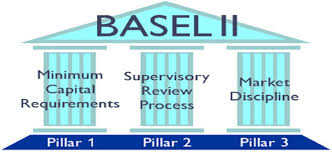The main objectives of this report is to discuss and analysis Managing the Composition of Capital as per Basel II in Bangladesh Banking sector. Here also focus on to present the theoretical background of Basel I, Basel II and Basel III also analysis the CAR of four commercial banks for the period of 2007, 2008, 2009 and 2010. Finally find out some problems perspective of Bangladesh and submit some recommendation. The study has used the Basel guideline prepared by Bangladesh Bank which has been moduled as per main regulations of Basel II give by the Basel Committee of Banking supervision (BCBS).
Introduction
Banking sector is very important for any country in the world. For the inflation banking sector are specially effected. For this reason, bank need to maintain their capital in such way that will reduce risk. The Basel Committee was established as the Committee on Banking Regulations and Supervisory Practices by the central-bank Governors of the Group of Ten countries at the end of 1974 in the aftermath of serious disturbances in international currency and banking markets. The first meeting took place in February 1975 and meetings have been held regularly three or four times a year since.
The Committee’s members come from Argentina, Australia, Belgium, Brazil, Canada, China, France, Germany, Hong Kong SAR, India, Indonesia, Italy, Japan, Korea, Luxembourg, Mexico, the Netherlands, Russia, Saudi Arabia, Singapore, South Africa, Spain, Sweden, Switzerland, Turkey, the United Kingdom and the United States.
The Basel Committee on Banking Supervision provides a forum for regular cooperation on banking supervisory matters. Its objective is to enhance understanding of key supervisory issues and improve the quality of banking supervision worldwide. In this regard, the Committee is best known for its international standards on capital adequacy; the Core Principles for Effective Banking Supervision; and the Concordat on cross-border banking supervision.
In 1988 the “Basle Committee on Banking Regulations and Supervisory Practices’ first released a capital adequacy framework, now known as Basel I. This initiative set out the internationally accepted framework for measuring capital adequacy and a minimum ratio to be achieved by the banks. This norm was widely adopted in over 100 countries, and in Bangladesh, it was implemented in 1990s. Over the years the Basel I framework was found to have several limitations, (BCBS, 1988)
On June 26, 2004, the Basel Committee on Banking Supervision (BCBS) released the document “International Convergence of Capital Measurement and Capital Standards: A Revised Framework”, which was supplemented in November 2005 by an update of the Market Risk Amendment. This document, popularly known as “Basel II Framework”, offers a new set of international standards for establishing minimum capital requirements for the banking organizations. It capitalizes on the modern risk management techniques and seeks to establish a more risk-responsive linkage between the banks’ operations and their capital requirements. It also provides a strong incentive to banks for improving their risk management systems. The risk sensitiveness is achieved through the three mutually reinforcing Pillars. (BCBS, 2004)
The New Accord has defined a structured framework comprising three pillars such as Pillar I, II and III. Pillar I sets out minimum capital requirements. Pillar II defines the process of supervisory review of a financial institution’s risk management framework. Pillar III determines market discipline through improved disclosure.
- Pillar I Minimum Capital Requirement
- Pillar II Supervisory Review
- Pillar III Market Discipline
From the above discussion the study issue has been taken to analysis the capital adequacy ratio of four commercial banks.
Objectives of the Study
The main objectives of the study are as follows :
- To present the theoretical background of Basel I, Basel II and Basel III.
- To analysis the CAR of four commercial banks for the period of 2007, 2008, 2009 and 2010.
- To compare the CAR of four commercial banks.
- To submit some recommendation.
Data and research methods of the study
In this study the following sources of data and methods are used.
Data sources:
Most of the data was collected from the secondary sources:
- A number of relevant books, journals.
- Annual report of selected banks.
- Websites, internet.
Theoretical Analysis
History of Basel
The Basel Committee was established as the Committee on Banking Regulations and Supervisory Practices by the central-bank Governors of the Group of Ten countries at the end of 1974 in the aftermath of serious disturbances in international currency and banking markets. The first meeting took place in February 1975 and meetings have been held regularly three or four times a year since.
The Committee’s members come from Belgium, Canada, France, Germany, Italy, Japan, Luxembourg, the Netherlands, Spain, Sweden, Switzerland, United Kingdom and United States. Countries are represented by their central bank and also by the authority with formal responsibility for the prudential supervision of banking business where this is not the central bank. The present Chairman of the Committee is Mr. William J. McDonough, President and Chief Executive Officer of the Federal Reserve Bank of New York.
In 1988, the Committee decided to introduce a capital measurement system commonly referred to as the Basel Capital Accord. This system provided for the implementation of a credit risk measurement framework with a minimum capital standard of 8% by end-1992. Since 1988, this framework has been progressively introduced not only in member countries but also in virtually all other countries with internationally active banks. In June 1999, the Committee issued a proposal for a revised Capital Adequacy Framework. The proposed capital framework consists of three pillars: minimum capital requirements, which seek to refine the standardised rules set forth in the 1988 Accord; supervisory review of an institution’s internal assessment process and capital adequacy; and effective use of disclosure to strengthen market discipline as a complement to supervisory efforts. Following extensive interaction with banks, industry groups and supervisory authorities that are not members of the Committee, the revised framework was issued on 26 June 2004. This text serves as a basis for national rule-making and for banks to complete their preparations for the new framework’s implementation.
Basel I
A set of international banking regulations put forth by the Basel Committee on Bank Supervision, which set out the minimum capital requirements of financial institutions with the goal of minimizing credit risk. Banks that operate internationally are required to maintain a minimum amount (8%) of capital based on a percent of risk-weighted assets. In 1988 the “Basle Committee on Banking Regulations and Supervisory Practices’ first released a capital adequacy framework, now known as Basel I. This initiative set out the internationally accepted framework for measuring capital adequacy and a minimum ratio to be achieved by the banks. This norm was widely adopted in over 100 countries, and in Bangladesh, it was implemented in 1990s. Over the years the Basel I framework was found to have several limitations such as its simplified approach to credit risk, its narrow coverage confined to only credit and market risks, and non-recognition of credit risk mitigants. (BCBS)
Basel II
Basel II is the second of the Basel Committee on Bank Supervision’s recommendations. On June 26, 2004, the Basel Committee on Banking Supervision (BCBS) released the document “International Convergence of Capital Measurement and Capital Standards: A Revised Framework”, which was supplemented in November 2005 by an update of the Market Risk Amendment. This document, popularly known as “Basel II Framework”, offers a new set of international standards for establishing minimum capital requirements for the banking organizations. It capitalizes on the modern risk management techniques and seeks to establish a more risk-responsive linkage between the banks’ operations and their capital requirements. It also provides a strong incentive to banks for improving their risk management systems. The risk sensitiveness is achieved through the three mutually reinforcing Pillars. (BCBS, 2004)
Conceptual Framework of the New Accord
The New Accord has defined a structured framework comprising three pillars such as Pillar I, II and III. Pillar I sets out minimum capital requirements. Pillar II defines the process of supervisory review of a financial institution’s risk management framework. Pillar III determines market discipline through improved disclosure.
Pillar I Minimum Capital Requirement
In Pillar I, three kinds of risk such as credit risk, market risk and operational risk are considered to determine the minimum capital requirement. The definition of eligible regulatory capital remains the same as outlined in the 1988 Accord i.e., the ratio of capital to risk-weighted asset remains unchanged at 8%.
Pillar II Supervisory Review
Pillar II ensures that not only do banks have adequate capital to cover their risks, but also that they employ better risk management practices so as to minimize the risks. Supervisors will be expected to evaluate the board and management of banks, to look into strategic decisions and to evaluate portfolio diversification as well as the ability to react to future risks in a rapidly changing environment. In particular, issues of transparency, corporate governance and efficient markets can be considered as additional challenges in pillar II enforcement.
Pillar III Market Discipline
Banking operations are becoming complex and difficult for supervisors to monitor and control. In this context, Basel Committee has recognized the importance of market discipline and has suggested implementing it by asking banks to make adequate disclosures. The potential audiences of these disclosures are supervisors, bank’s customers, rating agencies, depositors and investors. With frequent and material disclosures, outsiders can learn about the bank’s risks.
Bangladesh Bank Guidelines on Risk Based Capital Adequacy (RBCA) for Banks
These guidelines are issued by Bangladesh Bank (BB) under section 13 and section 45 of Bank Company Act 1991. BB has introduced these guidelines considering present complexity and diversity in the banking industry and to make the banks’ capital more risk sensitive and shock absorbent. BB has made these guidelines as statutory compliance for all scheduled banks in Bangladesh from January 01, 2010.
These guidelines have been prepared in accordance with “International Convergence of Capital Measurement and Capital Standards: A Revised Framework” of June, 2006 (popularly known as ‘Basel II Capital Adequacy Framework’) released by Basel Committee on Banking Supervision (BCBS). These guidelines will be called as ‘Guidelines on Risk Based Capital Adequacy (RBCA) for Banks’.
These guidelines are structured on following three aspects:
- Minimum capital requirements to be maintained by a bank against credit, market and operational risks.
- Process for assessing the overall capital adequacy aligned with risk profile of a bank and capital growth plan accordingly.
- Framework of public disclosure on the position of bank’s risk profiles, capital adequacy and risk management system.
Scope of application
These guidelines apply to all scheduled banks on ‘Solo’ basis as well as on ‘Consolidated’ basis where-
-‘Solo Basis’ refers to all position of the bank and its local and overseas branches/offices; and
-‘Consolidated Basis’ refers to all position of the bank (including its local and overseas branches/offices) and its subsidiary company(ies) engaged in financial (excluding insurance) activities like merchant banks, brokerage firms, discount houses, etc (if any).
Capital base
Regulatory capital will be categorized into three tiers: Tier-1, Tier-2, and Tier-3.
Tier 1 capital
Tier 1 capital called ‘Core Capital’ comprises of highest quality capital elements that includes
a) Paid up capital
b) Non-repayable share premium account
c) Statutory reserve
d) General reserve
e) Retained earnings
f) Minority interest in subsidiaries
g) Non-cumulative irredeemable preference shares
h) Dividend equalization account
Tier 2 capital
Tier 2 capital called ‘Supplementary Capital’ represents other elements which fall short of some of the characteristics of the core capital but contribute to the overall strength of a bank and will include:
- General provision
- Revaluation reserves
- Revaluation reserve for fixed assets
- Revaluation reserve for securities
- Revaluation reserves of equity instrument k) All other preference shares
Tier 3 capital
Tier 3 capital, called ‘Additional Supplementary Capital’, consists of short-term subordinated debt (original maturity less than or equal to five years but greater than or equal to two years) would be solely for the purpose of meeting a proportion of the capital requirements for market risk.
For Foreign banks
Operating in Bangladesh, Tier 1 capital consists of the following items:
a) Funds from head office
b) Remittable profit retained as capital
c) Any other items approved by BB for inclusion in Tier 1 capital
Tier 2 capital
Consists of the following items:
- General provision
- Borrowing from head office in foreign currency in compliance with the regulatory requirement as specified in Subordinated Debt.
- Revaluation reserve for securities
- Any other items approved by BB for inclusion in Tier 2 capitals
Conditions for maintaining regulatory capital
The calculation of Tier 1 capital, Tier 2 capital, and Tier 3 capital shall be subject to the following conditions:
- The amount of Tier 2 capital will be limited to 100% of the amount of Tier 1 capital.
- 50% of revaluation reserves for fixed assets and securities eligible for Tier 2 capital.
- 10% of revaluation reserves for equity instruments eligible for Tier 2 capital.
- Subordinated debt shall be limited to a maximum of 30% of the amount of Tier 1.
- A minimum of about 28.5% of market risk needs to be supported by Tier 1 capital. Supporting of Market Risk from Tier 3 capital shall be limited up to maximum of 250% of a bank’s Tier 1 capital that is available after meeting credit risk capital requirement.
Eligible regulatory capital
In order to obtain the eligible regulatory capital for the purpose of calculating Capital Adequacy Ratio (CAR), banks are required to make following deductions from their Tier-1 capital;
a) Book value of goodwill and value of any contingent assets which are shown as assets
b) Shortfall in provisions required against classified assets
c) Shortfall in provisions required against investment in shares
d) Remaining deficit on account of revaluation of investments in securities after netting off from any other surplus on the securities.
e) Reciprocal crossholdings of bank capital/subordinated debt artificially intended to inflate the capital position of banks
f) Any investment exceeding the approved limit under section 26(2) of, Bank Company Act 1991. The additional amount of investment will be deducted at 50% from Tier 1 capital and 50% from Tier 2 capital.
g) Investments in subsidiaries which are not consolidated. The normal practice will be to consolidate subsidiaries for the purpose of assessing the capital adequacy of banking groups. Where this is not done, deduction is essential to prevent the multiple uses of the same capital resources in different parts of the group. The deduction for such investments will be 50% from Tier 1 capital and 50% from Tier 2 capital. The assets representing the investments in subsidiary companies whose capital had been deducted from that of the parent would not be included in total assets for the purposes of computing the CAR.
Eligible Tier 2 capital will be derived after deducting components if any qualified for deduction.
Total eligible regulatory capital will be calculated by summing up the eligible Tier 1, Tier 2 and Tier 3 capital.
Total Eligible Regulatory Capital= (Tier1 capital+ Tier2 capital+Tier3 capital)
Calculation of CAR
In order to calculate CAR, banks are required to calculate their Risk Weighted Assets (RWA) in respect of credit, market, and operational risks. Total RWA will be determined by multiplying capital charge for market risk and operational risk by the reciprocal of the minimum CAR and adding the resulting figures to the sum of risk weighted assets for credit risk. The CAR is then calculated by taking eligible regulatory capital as numerator and total RWA as denominator.
Minimum capital requirements
- No Scheduled Bank in Bangladesh shall commence and carry on its business unless it has the minimum required capital as per section 13 of Bank Company Act 1991.
- Banks have to maintain CAR on ‘Solo’ basis as well as on ‘Consolidated’ basis as per instruction(s) given by BB from time to time.
- Banks shall also maintain a minimum Capital Adequacy Ratio (CAR) of at least 10% of Risk Weighted Assets (RWA) with core capital (Tier-1) not less than 5% of RWA*. CAR would be derived dividing total Eligible Regulatory Capital by RWA and multiplied by 100.
Total Risk weighted Assets (RWA)
Total Risk Weighted Assets (RWA) will be determined by multiplying capital charge for market risk and operational risk by a factor of 10 (i.e., the reciprocal of the minimum capital adequacy ratio of 10%) and adding the resulting figures to the sum of risk weighted assets for credit risk.
Total RWA = RWA for Credit Risk + 10 × (Capital Charge for Market Risk + Capital Charge for Operational Risk)
Basel III
On 1 June 2011, the Basel Committee on Banking Supervision announced that it has completed its review of and finalised the Basel III capital treatment for counterparty credit risk in bilateral trades. The Basel Committee issued today the Basel III rules text, which presents the details of global regulatory standards on bank capital adequacy and liquidity agreed by the Governors and Heads of Supervision, and endorsed by the G20 Leaders at their November Seoul summit. The Committee also published the results of its comprehensive quantitative impact study (QIS). (BCSB, 2011)
Mr. Nout Wellink, Chairman of the Basel Committee on Banking Supervision and President of the Netherlands Bank, described the Basel III Framework as “a landmark achievement that will help protect financial stability and promote sustainable economic growth. The higher levels of capital, combined with a global liquidity framework, will significantly reduce the probability and severity of banking crises in the future.” He added that “with these reforms, the Basel Committee has delivered on the banking reform agenda for internationally active banks set out by the G20 Leaders at their Pittsburgh summit in September 2009”. (Mr. Nout Wellink, 2011)
The rules text presents the details of the Basel III Framework, which covers both micro prudential and macro prudential elements. The Framework sets out higher and better-quality capital, better risk coverage, the introduction of a leverage ratio as a backstop to the risk-based requirement, measures to promote the buildup of capital that can be drawn down in periods of stress, and the introduction of two global liquidity standards.
Transition and implementation
The Committee has put in place processes to ensure the rigorous and consistent global implementation of the Basel III Framework. The standards will be phased in gradually so that the banking sector can move to the higher capital and liquidity standards while supporting lending to the economy. With respect to the leverage ratio, the Committee will use the transition period to assess whether it’s proposed design and calibration is appropriate over a full credit cycle and for different types of business models. Based on the results of a parallel run period, any adjustments would be carried out in the first half of 2017 with a view to migrating to a Pillar 1 treatment on 1 January 2018 based on appropriate review and calibration.
Both the Liquidity Coverage Ratio (LCR) and the Net Stable Funding Ratio (NSFR) will be subject to an observation period and will include a review clause to address any unintended consequences.
Mr. Wellink noted that “the Basel III capital and liquidity standards will gradually raise the level of high-quality capital in the banking system, increase liquidity buffers and reduce unstable funding structures. The transition period provides banks with ample time to move to the new standards in a manner consistent with a sound economic recovery, while raising the safeguards in the system against economic or financial shocks”. He added that in the case of the liquidity standards, “we will use the observation period for the liquidity ratios to ensure that we have their design and calibration right and that there are no unintended consequences, at either the banking sector or the broader system level”. (Mr. Wellink, 2011)
The Basel Committee and the Financial Stability Board (FSB) are also issuing an updated report of the Macroeconomic Assessment Group which analyses the economic impact of the Basel III reforms over the transition period. The updated report and a separate press release will be issued in the coming days.
The Committee is conducting further work on systemic banks and contingent capital in close coordination with the FSB. In the coming days, the Committee will also issue a consultation paper on the capitalisation of bank exposures to central counterparties.
Findings and Their Analysis
The capital position of the selected Banks as per Basel II
As per directives of the Bangladesh Bank, every schedule commercial banks in Bangladesh have to submit a Risk Based Capital Adequacy Statement on a quarterly basis according to RBCA guideline. In this statement, banks have to focus mainly on the Eligible Capital, Minimum Capital Requirement and Capital Adequacy Ratio of the bank.
The below portion of this report will going to measure the CAR of a renowned bank of Bangladesh based on the original data and information.
Capital Structure of selected Banks
The Capital Structure of United commercial Bank Limited, First Security Islami Bank Limited, Mutual Trust Bank Limited & City Bank Limited consists of Tier1 and Tier2 capital.
Table-1: Component of Tier1, Tier2 and RWA of the selected banks; (2007)
| Types of capital | Financial year 2007 | |||
| UCBL | FSIBL | MTBL | CBL | |
| Total Capital Tier1 | 313.72 | 113.43 | 192.55 | 231.27 |
| Total Capital Tier2 | 55.93 | 21.36 | 44.54 | 84.36 |
| Total Capital (Tier1+Tier2) | 369.64 | 134.79 | 237.10 | 315.63 |
| Total risk weighted assets | 4695.78 | 1473.62 | 2327.83 | 2503.69 |
Source: Banks annual report of 2007
Table-2: Component of Tier1, Tier2 and RWA of the selected banks; (2008)
| Types of capital | Financial year 2008 | |||
| UCBL | FSIBL | MTBL | CBL | |
| Total Capital Tier1 | 390.197 | 253.86 | 248 | 271.08 |
| Total Capital Tier2 | 87.823 | 32.36 | 40.83 | 124.27 |
| Total Capital (Tier1+Tier2) | 478.038 | 286.22 | 288.83 | 395.35 |
| Total risk weighted assets | 5306.52 | 1735.65 | 2781.09 | 3591.89 |
Source: Banks annual report of 2008
Table-3: Component of Tier1, Tier2 and RWA of the selected banks; (2009)
| Types of capital | Financial year 2009 | |||
| UCBL | FSIBL | MTBL | CBL | |
| Total Capital Tier1 | 483.49 | 286.54 | 330.06 | 298.59 |
| Total Capital Tier2 | 120.01 | 51.36 | 66.87 | 127.21 |
| Total Capital (Tier1+Tier2) | 603.50 | 337.90 | 396.93 | 425.80 |
| Total risk weighted assets | 6544.01 | 3111.34 | 4315.26 | 4109.68 |
Source: Banks annual report of 2009
Table-4: Component of Tier1, Tier2 and RWA of the selected banks; (2010)
| Types of capital | Financial year 2010 | |||
| UCBL | FSIBL | MTBL | CBL | |
| Total Capital Tier1 | 701.65 | 392 | 330.06 | 298.59 |
| Total Capital Tier2 | 206.76 | 66.22 | 66.87 | 127.21 |
| Total Capital (Tier1+Tier2) | 908.50 | 458.22 | 396.93 | 425.80 |
| Total risk weighted assets | 14408.06 | 3111.34 | 4315.26 | 5042.39 |
Source: Banks annual report of 2010
Tier1 capital of the bank includes Paid-up capital, Non-repayable share premium account, statuary reserve, General reserve, Retain earnings, Minority interest in subsidiary, Non-cumulative irredeemable preference share and Dividend equalization fund. Tier1 capital also called “Core Capital” of the banks.
Tier2 capital consist of general provision, revaluation reserves for fixed assets, security and equity instruments, all other preference shares and Subordinated bond.
Tier 1 capital in Banks CAR; 2007, 2008, 2009 and 2010
Table: 5 Tier1 capitals of selected Banks CAR.
| Banks Name | 2007 | 2008 | 2009 | 2010 | ||||
| Actual | Required | Actual | Required | Actual | Required | Actual | Required | |
| UCBL | 7.87% | 4.5% | 8.44% | 4.5% | 7.39% | 4.5% | 4.86% | 4.5% |
| FSIBL | 7.70% | 4.5% | 14.63% | 4.5% | 9.20% | 4.5% | 7.92% | 4.5% |
| MTBL | 8.28% | 4.5% | 8.92% | 4.5% | 7.65% | 4.5% | 7.92% | 4.5% |
| CBL | 9.24% | 4.5% | 7.55% | 4.5% | 7.27% | 4.5% | 6.84% | 4.5% |
Source: Banks annual report; 2007 to 2010
According to Bangladesh Bank guidelines all commercial banks are required to maintain their Tier1 capital minimum 5% of RWA.
All banks maintain their Tier1 capital above 5%.
In 2007 CBL Tier1 capital proportion was the highest at 9.24% and the FSIBL Tier1 capital proportion is the lowest at 7.77%. Whereas, UCBL, MTBL Tier1 were 7.82% & 8.28%.
In 2008 FSIBL Tier1 capital proportion was the highest at 14.63% and the CBL Tier1 capital proportion was the lowest at 7.55%. Whereas, UCBL, MTBL Tier1 were 8.44% & 8.92%.
In 2009 FSIBL Tier1 capital proportion was the highest at 9.20% and the CBL Tier1 capital proportion was the lowest at 7.27%. Whereas, Whereas, UCBL, MTBL Tier1 were 7.39% & 7.65%.
In 2010 FSIBL & MTBL Tier1 capital proportion was the highest at 7.92 and the UCBL Tier1 capital proportion is the lowest at 4.86%. Where was, CBL Tier1 was 6.84%.
Tier 2 capital in Banks CAR; 2007, 2008, 2009 and 2010
Table: 6 Tier2 capitals of selected Banks CAR.
| Banks Name | 2007 | 2008 | 2009 | 2010 | ||||
| Actual | Required | Actual | Required | Actual | Required | Actual | Required | |
| UCBL | 1.41% | 4.5% | 1.90% | 4.5% | 1.83% | 4.5% | 1.44% | 4.5% |
| FSIBL | 1.45% | 4.5% | 1.86% | 4.5% | 1.68% | 4.5% | 1.31% | 4.5% |
| MTBL | 1.91% | 4.5% | 1.47% | 4.5% | 1.55% | 4.5% | 3.57% | 4.5% |
| CBL | 3.37% | 4.5% | 3.46% | 4.5% | 3.10% | 4.5% | 3% | 4.5% |
Source: Banks annual report; 2007 to 2010
According to Bangladesh Bank guidelines all commercial banks are required to maintain their Tier2 capital maximum 5% of RWA.
All banks maintain their Tier2 capital less than 4.5%.
In 2007 CBL Tier2 capital proportion was the highest at 3.37% and the UCBL Tier2 capital proportion was the lowest at 1.41%. Whereas, FSIBL, MTBL Tier2 were 1.45% & 1.91%.
In 2008 CBL Tier2 capital proportion was the highest at 3.46% and the MTBL Tier2 capital proportion was the lowest at 1.47%. Whereas, UCBL, FSIBL Tier2 were 1.90% & 1.86%.
In 2009 CBL Tier2 capital proportion was the highest at 3.10% and the MTBL Tier2 capital proportion was the lowest at 1.55%. Whereas, UCBL, FSIBL Tier2 were 1.83% & 1.68%.
In 2010 MTBL Tier2 capital proportion is the highest at 3.57% and the FSIBL Tier2 capital proportion was the lowest at 1.31%. Whereas, UCBL, CBL Tier2 were 1.44% & 3%.
Total Capital Adequacy Ratio (CAR) of selected Banks
Table: 7 Capital Adequacy Ratio (CAR) of selected Banks
| Banks Name | 2007 | 2008 | 2009 | 2010 | ||||
| Actual | Required | Actual | Required | Actual | Required | Actual | Required | |
| UCBL | 9.28% | 10% | 10.34% | 10% | 9.22% | 10% | 6.31% | 10% |
| FSIBL | 9.15% | 10% | 16.49% | 10% | 10.91% | 10% | 9.09% | 10% |
| MTBL | 10.19% | 10% | 10.39% | 10% | 9.20% | 10% | 11.49% | 10% |
| CBL | 12.61% | 10% | 11.01% | 10% | 10.37% | 10% | 9.84% | 10% |
Source: Banks annual report; 2007 to 2010
This table shows the four commercial banks CAR in 2007 to 2011.
Recommendation
In order solve above problems the following recommendation authority should consider the recommendation:
- Every bank should ensure training facilities for their employees about Basel.
- Bangladesh Bank should take responsibility to develop perfect software for calculation of RWA and CAR.
- Every bank should open their new department that wills only deals with Basel requirement.
- Finally, Basel committee should develop new and effective process for RWA calculation.
Basel II recommendation is helpful in various ways to the Bangladesh banking sector. Improve overall efficiency of banking and finance system.
Conclusion
By requiring banks to determine capital adequacy based on the level of risk posed by specific business activities, banks will have to develop and use various risk based capital planning models. The business benefits a bank can derive from such risk based capital approaches extend beyond Basel II compliance. Because it links earnings to risks, risk based capital enables banks to identify business lines and business opportunities that create shareholder value. In addition to enabling banks to better identify and understand their risks, use of these approaches can help banks aggregate risk measures across all risk categories and business areas and ensure consistent allocation of capital to risks. A focus on risk based capital planning can help a bank optimize its incentive system to ensure compatibility of bank strategy and business-line management. Such a focus can also drive improvement in data collection and use and thus improve knowledge and awareness of risk and risk management throughout the organization. The challenge for banks will be to leverage the business benefits Basel II’s focus on risk based capital can help drive in their businesses. Leading institutions are seeking to monitor and understand their risks and capital usage, and then allocate and manage capital proactively. The development and implementation of a capital planning process – backed by the board and senior management and embraced by employees – is helping banks understand the capital implications of their risk-taking activities as well as helping them ensure their businesses are using capital efficiently.
















